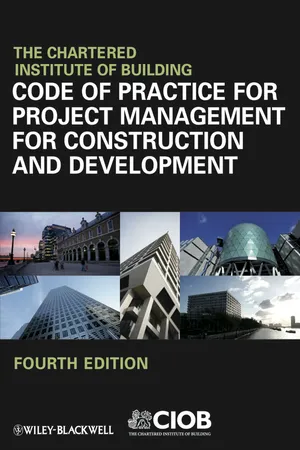![]()
Part 1: Project management
![]()
Chapter 1: Inception stage
Introduction
Complex capital projects require significant management skills, co-ordination of a wide range of people with different expertise and ensuring completion within the parameters of time, cost and quality specifications. The inception stage of any construction and development project requires the decision from the client that a potential project represents the best way of meeting a defined need.
In assessing the need for construction, key questions should include:
Why is the project needed?
How to incorporate sustainability and is the client’s corporate responsibility defined?
How best is the need be fulfilled? (For example, a new building, or refurbishment, or extension of existing structure, etc.)
What is a reasonable budget cost?
What is a reasonable time from inception to completion?
What are the investment and funding options?
What risks related to the development can be foreseen at this stage?
What benefits are expected as a result of the project?
Client’s objectives
The main objective at this stage for the client is to make the decision to invest in a construction or development project. The client should have prepared a business case (capital expenditure programme) involving careful analysis of its business, organisation, present facilities and future needs. Experienced clients may have the necessary expertise to prepare their business case themselves. Less experienced clients may need help. Many project managers are able to contribute to this process. This process will result in a project-specific statement of need. The client’s objective will be to obtain a totally functional facility, which satisfies this need and must not be confused with the project objectives, which will be developed later from the statement of need.
A sound business case prepared at this stage will:
be based on sound information and reasonable estimation
contain rational processes
be aware of the risks associated
maximise the scope of obtaining best value from resources
utilise previous experience
incorporate sustainability cost-effectively.
Client’s internal team
Investment decision-maker: this is typically a corporate team of senior managers and/or directors who review the potential project and monitors the progress. However, the team seldom is involved directly in the project process.
Project sponsor: typically a senior person in the client’s organisation, acting as the focal point for key decisions about progress and variations. The project sponsor has to possess the skills to lead and manage the client role, have the authority to take day-to-day decisions and have access to people who are making key decisions.
Client’s advisor: the project sponsor can appoint an independent client advisor (also referred to as construction advisor or project advisor or independent client advisor) who will provide professional advice in determining the necessity of construction and means or procurement, if necessary. If advice is taken from a consultant or a contractor, those organisations have a vested interest not only in confirming the client’s need, but also in selling their services and products.
The client advisor can assist with:
business case development (further guidance on this has been provided in Appendix 30)
designing and planning for sustainability
understanding the need for a project
deciding the type of project that meets the need
generating and appraising options (when appropriate)
selecting an appropriate option (when available)
risk assessment (when appropriate)
advising the client on the choice of procurement route
selecting and appointing the project team
measuring and monitoring performance (when appropriate).
The client advisor should understand the objectives and requirements of the client but should remain independent and objective in providing advice directly to the client. Other areas where the client may sought independent advice include: chartered accounting, tax and legal aspects, market research, town planning, chartered surveying and investment banking.
Project manager
Project managers can come from a variety of backgrounds, but all will need to have the necessary skills and competencies to manage all aspects of a project from inception to occupation. This role may be fulfilled by a member of the client’s organisation or be an external appointment.
Project manager’s objectives
The project manager, both acting on behalf of, and representing the client has the duty of ‘providing a cost-effective and independent service, selecting, correlating, integrating and managing different disciplines and expertise, to satisfy the objectives and provisions of the project brief from inception to completion. The service provided must be to the client’s satisfaction, safeguard his interests at all times, and, where possible, give consideration to the needs of the eventual user of the facility’.
The key role of the project manager is to motivate, manage, co-ordinate and maintain the morale of the whole project team. This leadership function is essentially about managing people and its importance cannot be overstated. A familiarity with all the other tools and techniques of project management will not compensate for shortcomings in this vital area. Further guidance on the leadership aspect of the project manager’s role has been provided in Appendix 21.
In dealing with the project team the project manager has an obligation to recognise and respect the professional codes of the other disciplines and, in particular, the responsibilities of all disciplines to society, the environment and each other. There are differences in the levels of responsibility, authority and job title of the individual responsible for the project, and the terms project manager, project coordinator and project administrator are all widely used.
It is essential, in order to ensure an effective and...



























